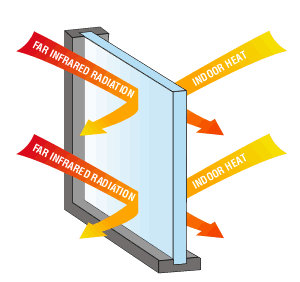[/caption]In the last few centuries, in which time we have had several scientific revolutions, our understanding of heat, energy and the exchange thereof has grown exponentially. In particular has been the increasing ability to gauge the amounts of energy involved in particular processes and in turn create theoretical frameworks, units, and even tools with which to measure them. One such concept is the measurement known as Emissivity. Essentially, this is the relative ability of a material’s surface (usually written ? or e) to emit energy as radiation. It is expressed as the ratio of the emissivity of the material in question to the radiation emitted by a blackbody (an idealized physical body that absorbs all incident electromagnetic radiation) at the same temperature. This means that while a true black body would have an emissivity value of 1 (? = 1), any other object, known as a “grey body”, would have an emissivity value of less than 1 (? < 1). In general, the duller and blacker a material is, the closer its emissivity is to 1. The more reflective a material is, the lower its emissivity. Emissivity also depends on such factors as temperature, emission angle, and wavelength of the radiation. At the opposite end of the spectrum is the material’s absorptivity (or absorptance), which is the measure of radiation absorbed by a material at a particular wavelength. When dealing with non-black surfaces, the relative emissivity follows Kirchhoff's law of thermal radiation which states that emissivity is equal to absorptivity. Essentially an object that does not absorb all incident light will also emit less radiation than an ideal black body. An important function for emissivity has to do with the Earth’s atmosphere. Like all other “grey bodies”, the Earth’s atmosphere is able to absorb and emit radiation. The overall emissivity of Earth's atmosphere varies according to cloud cover and the concentration of gases that absorb and emit energy in the thermal infrared (i.e. heat energy). In this way, and by using the same criteria by which they are able to calculate the emissivity of “grey bodies”, scientists are able to calculate the amount of thermal radiation emitted by the atmosphere, thereby gaining a better understanding of the Greenhouse Effect. Every known material has an emissivity coefficient. Those that have a higher coefficient tend to be polished metals, such as aluminum and anodized metals. However, certain materials that are not metals and are non-reflective, such as red bricks, asbestos, concrete and pressed carbon, have equally high coefficients. In addition, naturally occurring materials such as ice, marble, and lime also have high emissivity coefficients. We have written many articles about emissivity of materials for Universe Today. Here's an article about heat rejection systems, and here's an article about absorptivity. If you'd like more info on emissivity, check out these articles from Engineering Toolbox and Science World.
We’ve also recorded an entire episode of Astronomy Cast all about Electromagnetism. Listen here, Episode 103: Electromagnetism.
References:
http://en.wikipedia.org/wiki/Emissivity
http://en.wikipedia.org/wiki/Absorptance
http://en.wikipedia.org/wiki/Black_body
http://www.thefreedictionary.com/emissivity
http://www.monarchserver.com/TableofEmissivity.pdf

